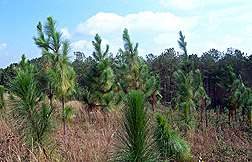Long-Term Effects of Carbon Dioxide on Plants Studied

(PhysOrg.com) -- Long-term, open-top chamber studies of how rising carbon dioxide (CO2) could affect crops, forests, and pastures reveal a wide range of impacts, according to Agricultural Research Service (ARS) scientists.
Plant physiologist Steve Prior at the ARS National Soil Dynamics Laboratory in Auburn, Ala., heads this research effort. He, plant pathologist Brett Runion, and other colleagues at the Auburn laboratory have found that fast-growing exotic weedy invasives such as Chinese privet, nutsedge and tropical spiderwort could become even more troublesome as CO2 levels increase to 550 parts per million as predicted by 2050.
For forest species such as longleaf pine, higher CO2 levels improve water use efficiency, which may improve drought tolerance, by causing leaf pores or stomates to stay partially closed longer.
In their studies, growth and survival of pine trees went up, while growth and survival of understory plants declined by half.
In addition to increased pine needle production under high CO2, the scientists also found some chemical changes in these needles that litter the forest floor, resulting in less nutritional content for millipedes and other bugs and microbes that feed on them. These changes may alter carbon and nutrient cycling in these natural systems.
And they found that higher CO2 can increase residues left from soybeans and other crops and affect the amount of nitrogen available to plants as microbes decompose the residue. Different soybean varieties may also have different effects on nitrogen availability in a high CO2 world.
In addition to weeds, Prior and Runion also saw effects on disease and insect pests, such as fusiform rust and the red headed pine sawfly.
The study supports the U.S. Department of Agriculture’s priority of responding to climate change.
Read more about this and other climate change research in the November-December 2009 issue of Agricultural Research magazine.
Provided by USDA Agricultural Research Service




















